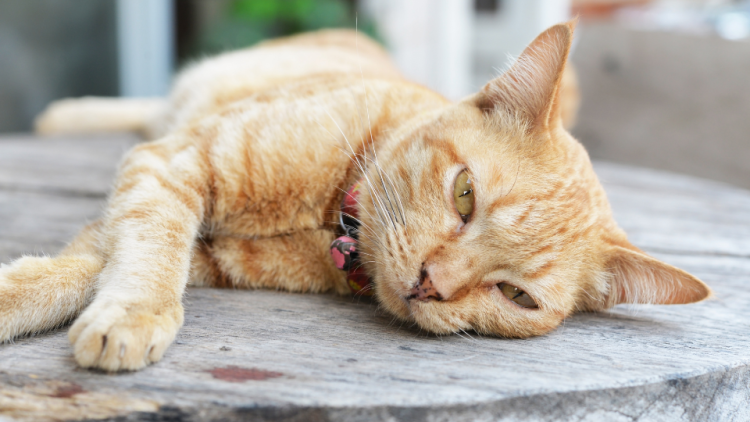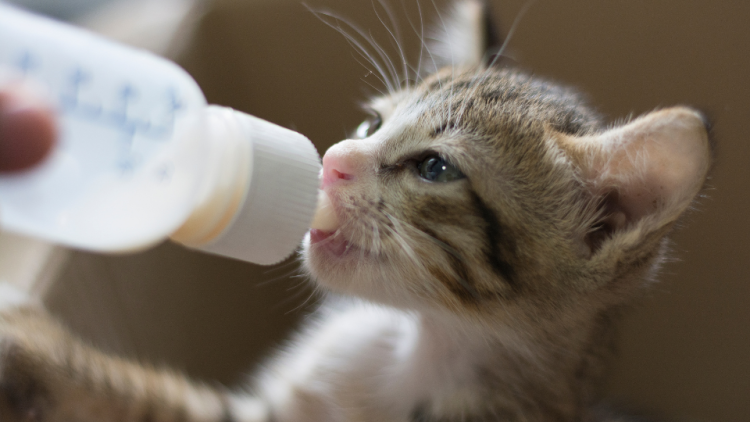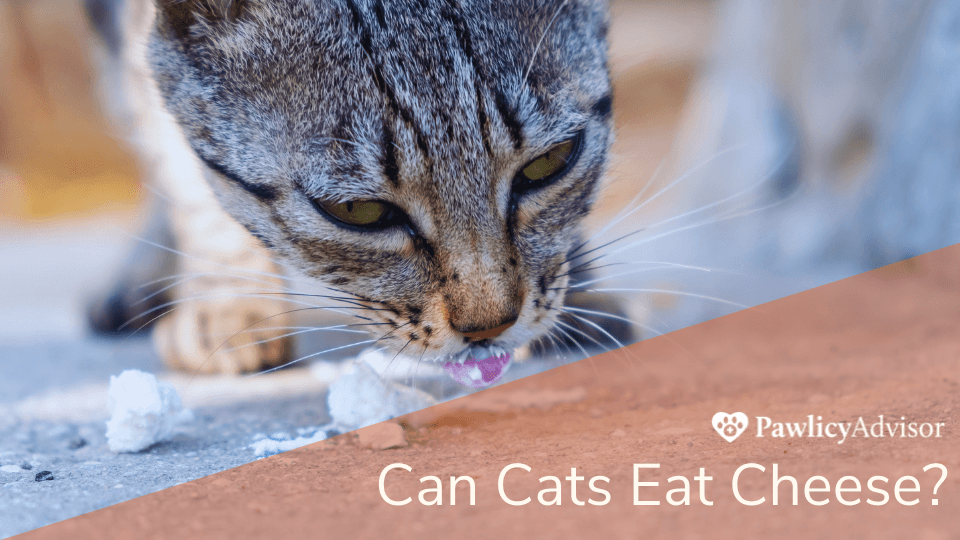Pictures of kittens lapping at a bowl of milk are common, but what happens as they grow up? Is dairy bad for cats, and if not, is it okay for cats to eat cheese?
Whether your feline friend snuck a curious bite off the kitchen counter or you’d like to award them a tasty treat, it’s always wise to ensure safety whenever you introduce a new food to a cat’s diet. Their digestive system can be extremely sensitive, and many human foods that are perfectly safe for us to eat can cause major health consequences in felines.
By the end of this article, you’ll know the pros and cons of feeding cats cheese, as well as what types of cheese are safe for cats (and which ones you should avoid at all costs!).
Table of Contents:
- Can cats eat cheese?
- Is cheese bad for cats?
- What types of cheese can cats eat?
- How to feed cheese to cats
- Can cats eat dairy products?
- Key Takeaways
Pro Tip: Pet insurance can offer a way to protect your finances if your cat gets its paws on something it shouldn’t have, requiring the need for emergency vet treatment. Ensure your loved one has access to gold-standard care at an affordable rate by enrolling in an insurance policy customized to your needs.
Can cats eat cheese?
Generally,cats can eat cheese in moderate amounts. Cheese is not toxic to cats, and most can safely consume the dairy product as an occasional treat.
Whether your cat actually needs to eat cheese is another question. Cats are obligate carnivores, meaning their diet requires nutrients only found in animal meat. Felines lack the necessary physiology to consume plant-based matter (although they can consume mineral and vegetable substances for non-nutritional reasons). In other words, dairy is not a natural part of a cat’s diet, and cheese does not offer them any nutritional benefits.
A healthy cat diet should consist of commercial-grade food, with treats making up no more than 10% of their daily calorie consumption.
When is cheese bad for cats?
While cats can eat cheese in small amounts, eating too much of it can cause gastrointestinal (GI) problems, including diarrhea, vomiting, nausea, bloating, and flatulence. Pet parents should be especially careful given the following considerations:
- Lactose intolerance
Many people believe that cats love dairy, but this is one of the most enduring myths about felines. In truth, most cats are lactose-intolerant and cannot digest dairy-based products like cheese very well. After they’re done weaning, felines do not produce an enzyme called lactase_ _that’s essential for breaking down the sugars that occur naturally in milk (known as lactose).
Some cats can tolerate dairy better than others, which is why some may rub up against your leg at the sight of a milk carton. If you’re wondering how to tell if your cat is lactose-intolerant, they will display notable symptoms of diarrhea within eight to 12 hours of consumption.
- Dairy allergies
While stomach upset due to lactose intolerance is never fun, it’s less likely to induce severe consequences than a dairy allergy, which impairs a cat’s ability to digest the proteins found in cheese, milk, and similar products. The risk of dairy allergy in cats may be relatively small, affecting 0.05% of the feline pet population. Allergic reactions may cause skin disorders and gut problems, even by consuming a very small amount of cheese. In rare cases, an anaphylactic reaction can occur, which has the potential to be life-threatening. Always monitor your pet closely after serving them new food and watch for signs of adverse reactions.
- High sodium content
If your pet has a health condition, such as kidney disease or heart disease, your vet may advise you to monitor their salt intake. Dairy contains a high volume of sodium, so some cats can’t eat cheese without risking their overall well-being. Consult your veterinarian if you have any concerns about your pet’s diet.
- High fat and calorie content
Cheese is also very high in caloric fat, so if your cat eats cheese** on a regular basis, they could quickly become overweight. According to Hill’s Pet Nutrition, a one-ounce cube of cheddar cheese served to an average ten-pound cat is the equivalent of a person eating two and one-half cheeseburgers in a single sitting! If weight gain leads to obesity, it can significantly reduce your cat’s life expectancy and cause a number of secondary health issues.
- Harmful additive ingredients
Some ingredients can make cheese bad for cats, so be very mindful of which type you offer. Certain additives often paired with cheesy spreads, such as garlic, onions, and chives, are highly toxic in pets. These members of the allium family can break down animals’ red blood cells, leading to anemia, so be sure to steer clear of them at all costs.

What types of cheese can cats eat?
Some types of cheese are more dangerous to cats than otheres. Let's take a look.
Can cats eat blue cheese?
Cats should not eat blue cheese or similar moldy varietals. Blue cheese, like Stilton, contains the mold Penicillium, which can be toxic to pets. Furthermore, although blue cheese is low in lactose (0.5 grams per 100 grams), it’s still high in fat.
Can cats eat parmesan cheese?
Hard cheese like parmesan contains less lactose than soft cheese (like mozzarella, cottage cheese, and cream cheese), which makes them easier for your cat to digest. Nonetheless, they should only be given on occasion and in moderate quantities.
Can cats eat goat cheese?
Goat cheese has the least amount of lactose and also contains less salt than hard types of cheese, so it’s generally considered the** safest cheese cats can eat.**
Can cats have non-dairy cheese?
If you’re wondering whether lactose-intolerant cats can eat non-dairy cheese, the unfortunate answer is no. Humans may find vegan options provide a tasty alternative, but non-dairy cheese is high in salt and fat, neither of which is good for your curious kitty.
How to feed cheese to cats
Taking everything into consideration, here are some tips on how to feed cats cheese safely if you decide to do so after consulting with your veterinarian:
- Cut a portion of cheese into bite-sized pieces that will be easy to chew and swallow.
- Check the label on the package to see how many calories the cheese contains, adjusted by serving size. Remember that it should not comprise more than 10% of your cat’s daily caloric intake. Your vet can help you calculate how much to feed your pet based on their weight, age, and nutritional needs.
- Be sure to also check the label for any potentially harmful ingredients before serving the cheese to your cat, such as garlic.
- Start by feeding the cat cheese in a very small amount of cheese so that you can monitor how your pet reacts to it. If they show signs of digestive distress, like diarrhea or vomiting, stop feeding the cat cheese and call your vet.
- Always consult your vet before giving a cat new human foods.
Pro Tip: Does your cat have a habit of getting into things they’re not supposed to? Pet insurance can help cover the cost of unexpected vet bills due to illness or injury, including accidental poisoning. Compare pet insurance plans to find the best solution for you and your pet.

Can cats have dairy products?
We know that our feline friends can consume cheese in small amounts, but what about other dairy products? Here’s a look at a few common options:
- Plain yogurt is easier for cats to digest compared to other dairy products because it contains ‘good’ bacteria that benefit the gut. Yogurt also has less lactose, so most cats can have a few bites without sensitivity.
- Ice cream is not the best choice for cats because it’s high in sugar and fat. In addition, certain flavors, like chocolate, might contain ingredients that are toxic to cats.
- Butter is bad for cats, as well. The high-fat content in butter can lead to obesity and secondary health complications. Although it often contains vitamins, these quantities are insufficient for cats.
- Sugar-free dairy products should never be given to cats, as many sugar substitutes that are safe for human consumption are poisonous to cats. This is especially true for xylitol, a common artificial sweetener found in many sugar-free products.
Key Takeaways
- Cats can eat cheese in small amounts, but beware of lactose intolerance and dairy allergies that could cause adverse reactions.
- As obligate carnivores, cats won’t gain nutritional benefits from dairy products like cheese, and eating these products too often could lead to weight gain.
- Pet insurance can help cat owners afford the cost of emergency vet visits by reimbursing a portion of the bill for covered services.
